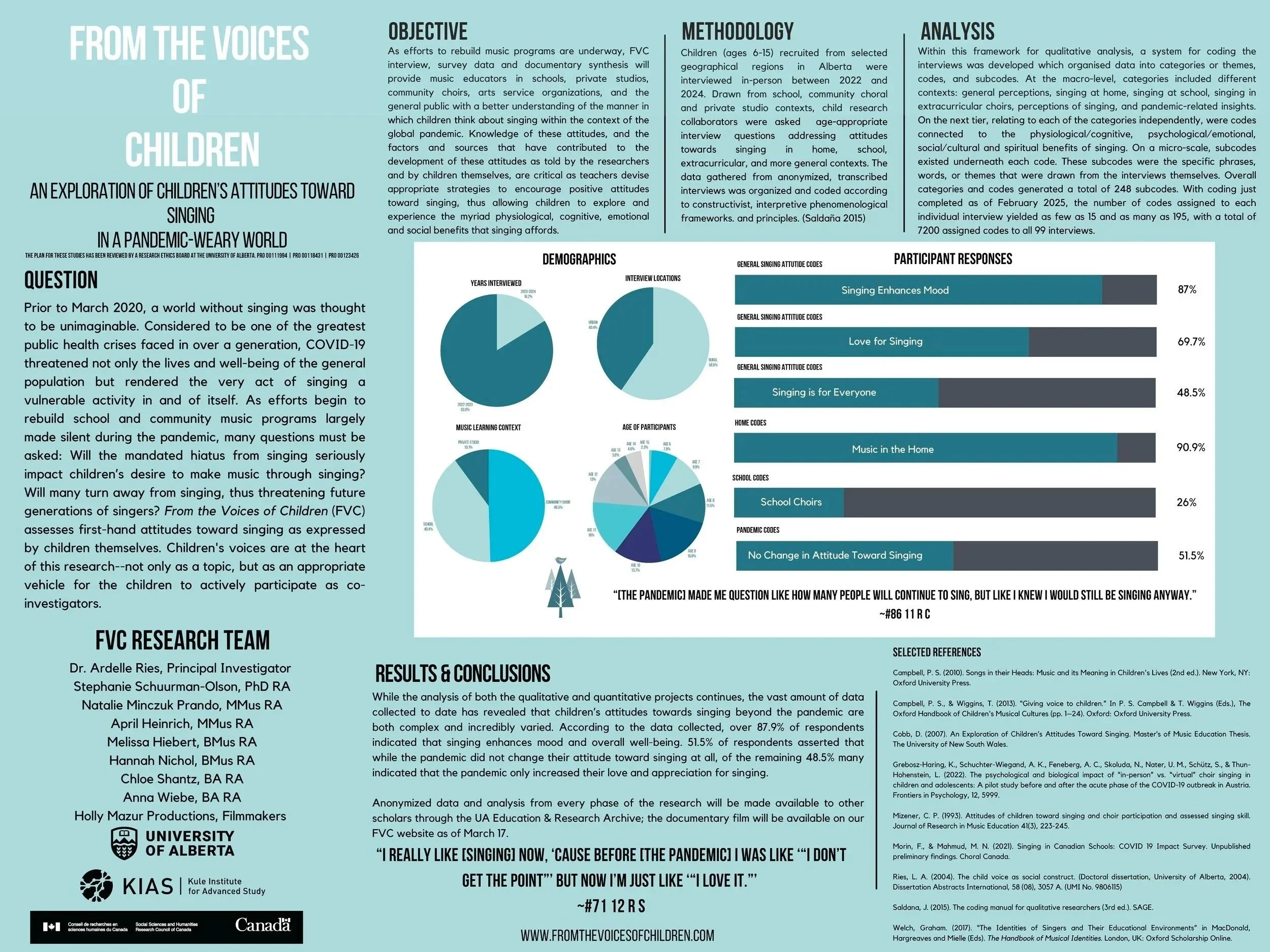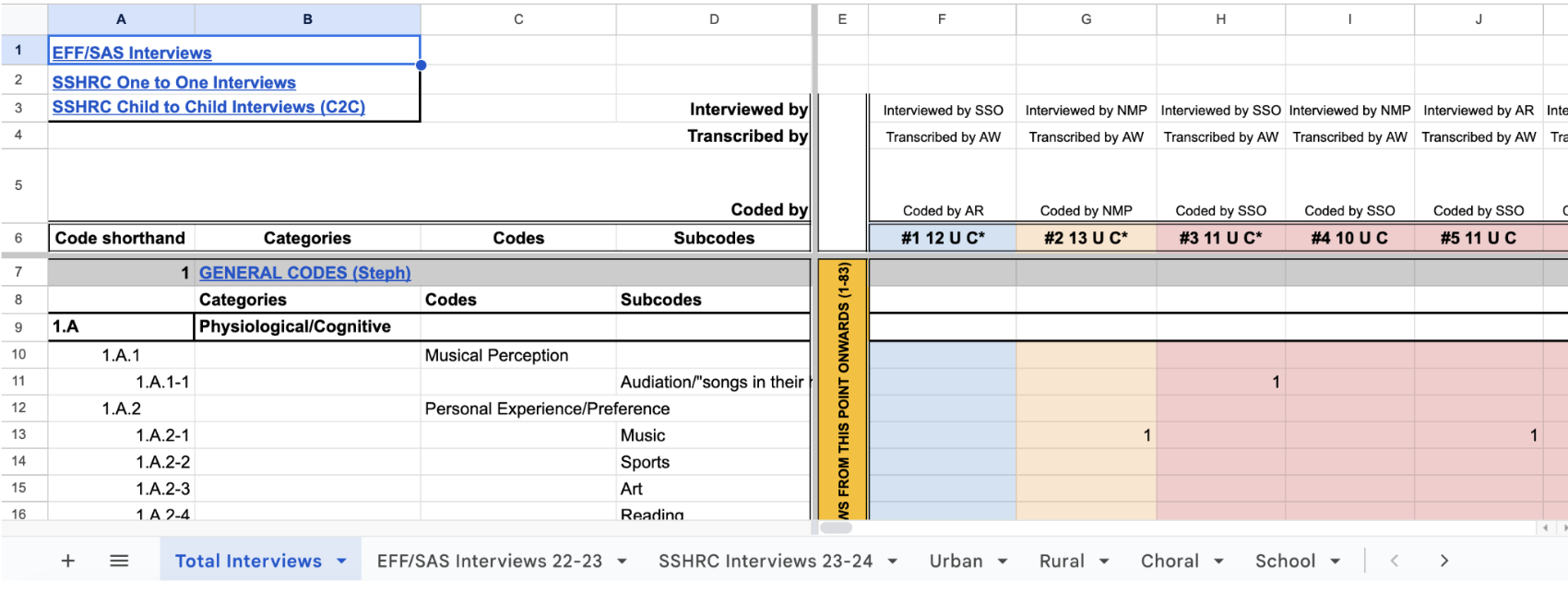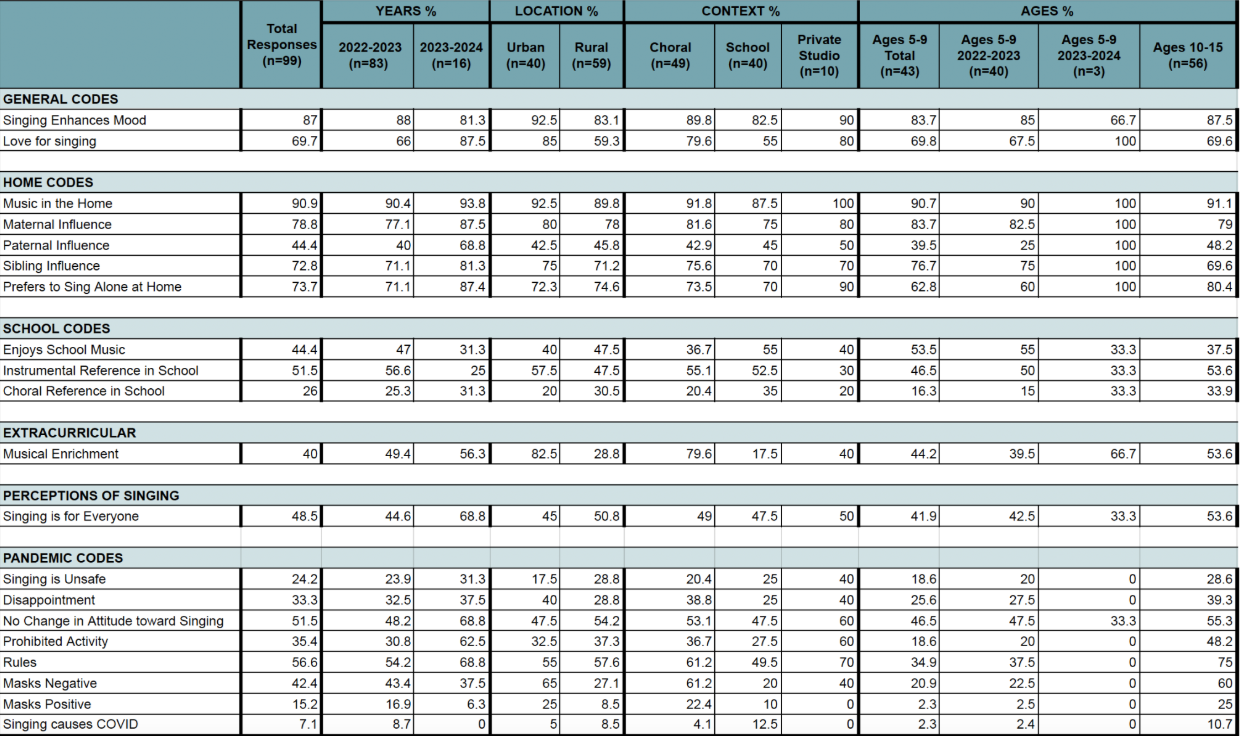Research | Methodology.
In an effort to generate a rich and rigorous collection of data, the From the Voices of Children study consisted of three different approaches to investigating the following questions:
With COVID-19 health restrictions now behind us, what are children's current attitudes toward singing in home, school, and community contexts?
What are the factors that contribute to these attitudes?
How have the COVID-19 pandemic and the related health restrictions since then influenced children’s perceptions and attitudes toward singing?
What are the benefits of singing for children, as identified by the children?
Each phase of the research employed a different method, data collection, and analysis.
The initial two studies were designed as pilot studies. The methods and findings of these first two pilot studies have greatly informed the third comprehensive study.
click below to learn more about each FVC research phase
-
Phase One of the FVC project was generously funded by the Endowment Fund for the Future (EFF) and the Support for the Advancement of Scholarship (SAS) at the UofA. Based on the FVC review of the current literature, it was thought that a qualitative approach would contribute to the field in more significant ways than a quantitative approach would offer. Where previous pandemic-related music education studies considered teacher and administrator perspectives (Morin & Mahmud, 2021), the perspectives of the children themselves could provide a more fulsome contribution to the ongoing conversation about the lasting impacts of COVID-19 on singing and musicking.
In the Spring and early Summer of 2022, the From the Voices of Children research team planned to conduct one-on-one interviews with 25-50 children between the ages of 6 and 12. Children from urban and rural areas within a 100 km radius of our UA Augustana campus in Camrose, Alberta, along with their guardians, responded to an open call for participants issued to community choral organizations, school divisions, and private studios.
In 1998, music educator and ethnomusicologist Patricia Shehan Campbell wrote Songs in Their Heads, an investigation into how children think about music and singing. While Campbell’s investigation included fifteen children, From the Voices of Children hoped to expand on her work to gain greater depth and breadth of understanding. However, our research team never could have anticipated the interest garnered by this study. The response was overwhelming. Though the goal was 25-50 interviewees, at the conclusion of the study, 83 children were interviewed, providing more than 22 hours of interview footage. Participation in the research project was voluntary, and both caregiver and child consented to the research agreement, which, in an attempt to challenge current child educational research practices, identified the child participants as co-researchers. Video and audio footage were taken during each interview, with identifying information removed before the AV files were transcribed. Our team of undergraduate research assistants transcribed the interviews.
-
Although the qualitative interview-based Phase 1 prioritized depth over breadth of data, it was evident that a larger sample size would lend additional validity to our findings. Where Phase 1 garnered 83 interview responses, Phase 2 aimed to hear from 250 research participants. For this phase of the project, colleagues suggested that a quantitative survey approach would be the most efficient and effective way to gather and analyze responses from a participant group of this size. Additionally, it was posited that an online survey would reach students in other areas of the province. Where Phase 1 was centred geographically within 100 km of Camrose in central Alberta, Phase 2 would be accessible online to students in both urban and rural areas in southern Alberta as well. Phase 1 respondents were drawn from school, community choir, and private music studio contexts. Since Phase 2 funding was available through a partnership grant between the Kule Institute for Advanced Studies and the Alberta Teachers’ Association (the ATA), Phase 2 respondents would be recruited from school jurisdictions. This focus on school settings would balance the data source responses and perspectives, providing a clearer picture of the pandemic's impact on school music programs.
The anonymous online survey was designed for children within the public school system to complete in their own homes. Guardians accessed the survey and completed the parental consent form before passing their device to their child, who would then complete the child assent form and continue to the survey. The survey existed as two versions — one created for children ages 9-12 who had experienced school-based music-making in pre-pandemic times, and the other for children ages 6-8 who would have been very new to the school experience or even entered into the school system when COVID-19-related restrictions were already in place. Interview questions were adapted from Phase 1 to suit survey-style responses, and children answered questions using a prescribed Likert scale. Inspired by Cobb’s (2007) survey, our survey utilized emojis paired with common numerical and descriptive responses in an attempt to make the survey appealing and accessible to children. The survey took students approximately 20 minutes to finish, and was available to complete online between February and June of 2023.Students accessed the survey via QR code published in school newsletters, school social media accounts, and school websites. The survey itself was created using a combination of Google Forms, a third-party application called Formfacade, and the web design software Squarespace. The survey in its different forms existed on a unique, password-protected From the Voices of Children domain page: www.fromthevoicesofchildren.com. Because the survey was created through Google Forms, student responses were automatically recorded and charted through the application. Analysis is currently underway, involving the synthesis of results from multiple survey versions to generate summative responses.
Because the funding for this phase of the project came from the ATA — the Alberta school teachers’ professional governing body and labour union — it was necessary to carry out this phase of FVC in partnership with school divisions across the province. Ethics approval was granted for research within 5 different school divisions across Alberta. From those 5 divisions, 62 school principals were contacted about participating in the study. Of the 62 contacted, only 14 schools responded favourably. When the survey closed mid-June 2023, we had received a total of 17 student responses. Due to the stringent ways in which researchers gain ethical access to students from within the school systems, our response numbers were significantly lower than the ~250 we hoped to collect.
-
In the final phase of the From the Voices of Children research, our team comprehensively explored the attitudes of children (aged 9-15) drawn from school, studio, and community choral settings across the province of Alberta through both qualitative one-on-one interviews and quantitative online survey methods during the 2023/2024 academic year.
While Phase 1 and Phase 2 of From the Voices of Children operated as pilot projects, Phase 3 was a multi-method, comprehensive study. Informed by the successes and challenges discovered during Phase 1 and Phase 2, Phase 3 generated both qualitative and quantitative data through interviews and surveys conducted in a wider geographical area within the province of Alberta.
-
The video and audio recordings collected during the interview process, paired with additional footage filmed in February 2024, have been used in the creation of a 15-minute documentary that reveals children’s own perceptions of singing. This short film was released to enthusiastic audiences in March 2025.
We intend for this short film to serve as an advocacy tool for music educators as rebuilding efforts continue in the wake of the COVID-19 pandemic. In keeping with the title of our project and with children’s voices literally and figuratively centred through their interviews with each other, the core philosophy of this film is that adult voices are largely absent, revealing the attitudes, perspectives and lived experiences of the children themselves. Funded by the Social Sciences and Humanities Research Council through an Insight Development Grant, this aspect of Phase Three is based on a partnership between the University of Alberta and local Alberta documentarian, Holly Mazur Productions.
Research | Transcription & CODING PROCEDURES
With a mandate at any research institution dedicated to the mentorship of future researchers, integral to the research process, a stellar team of undergraduate RAs were employed to complete the interview transcriptions. This dedicated team generated 865 pages from 99 transcribed interviews.
In terms of qualitative data analysis, Phase One & Phase Three employed a constructivist, interpretive phenomenological framework to construct and interpret the “phenomenon” or experience of the research participants through the frequency with which particular themes or codes are referenced within each interview.
Within this framework of qualitative analysis, a system for coding the interviews was developed, which organized data into categories or themes, codes, and subcodes. At the macro-level, categories included different contexts: general perceptions, singing at home, singing at school, singing in extracurricular choirs, perceptions of singing, and pandemic-related insights. On the next tier, relating to each of the categories independently, were codes connected to the physiological/cognitive, psychological/emotional, social/cultural and spiritual benefits of singing. On a micro-scale, subcodes existed underneath each code. These subcodes were the specific phrases, words, or themes that were drawn from the interviews themselves. Overall categories and codes generated, a total of 248 subcodes. With coding complete as of February 2025, the number of codes assigned to each individual interview ranged from as few as 15 to as many as 195, with a total of 7200 codes assigned to all 99 interviews. We are grateful for the insights that these 99 children so generously shared.

RESEARCH | PUBLICATIONS
[Coming Soon]
RESEARCH | EVENTS & PRESENTATIONS
August 2025 Proceedings of the 27th International Kodály Symposium, Kecskemet, Hungary
October 2024 Proceedings of Music Conference Alberta, Edmonton, Alberta, Canada
May 2024 Proceedings of Podium 2024, Choral Canada National Conference, Montréal, Quebec, Canada
August 2023 Proceedings of the 25th International Kodály Symposium, Los Angeles, California, USA
April 2023 University of Alberta Augustana Faculty World Cafe, Camrose, Alberta, Canada
References
Blacking, J. (1974). How Musical is Man? (1st paperback edition). University of Washington Press.
Campbell, P. S. (2010). Songs in their Heads: Music and its Meaning in Children's Lives (2nd ed.). New York, NY: Oxford University Press
Campbell, P. S., & Wiggins, T. (2013). “Giving voice to children.” In P. S. Campbell & T. Wiggins (Eds.), The Oxford Handbook of Children's Musical Cultures (pp. 1–24). Oxford: Oxford University Press.
Cannella, G. S. (1997). Deconstructing early childhood education: Social Justice and revolution. Peter Lang.
Carson, R. (2003). Silent spring (40th anniversary ed.). Houghton Mifflin.
Choral Canada. (2020). Benefits of singing. Choral Canada. https://www.choralcanada.org/benefits-of-singing. Accessed 03/30/23.
Cobb, D. (2007). An Exploration of Children’s Attitudes Toward Singing. Master’s of Music Education Thesis. The University of New South Wales.
Colapinto, J. (2021). This is the Voice. New York, NY: Simon & Schuster.
Glew, S. G., Simonds, L. M., & Williams, E. I. (2021). The effects of group singing on the wellbeing and psychosocial outcomes of children and young people: a systematic integrative review. Arts & Health, 13(3), 240-262.
Grebosz-Haring, K., Schuchter-Wiegand, A. K., Feneberg, A. C., Skoluda, N., Nater, U. M., Schütz, S., & Thun-Hohenstein, L. (2022). The psychological and biological impact of “in-person” vs.“virtual” choir singing in children and adolescents: A pilot study before and after the acute phase of the COVID-19 outbreak in Austria. Frontiers in Psychology, 12, 5999.
Guba, E. G., & Lincoln, Y. S. (2005). Paradigmatic controversies, contradictions and emerging confluences, In N. K. Denzin & Y. S. Lincoln (Eds.). The SAGE Handbook of Qualitative Research, (3rd ed.) (191-215). Thousand Oaks, CA: Sage Publications Ltd.
Knight, S. (2002). Exploring a cultural myth: What adult non-singers may reveal about the Nature of singing. In A. Rose, K. Adams & L. Chisholm (Eds.), Sharing the Voices: the Phenomenon of Singing: Proceedings of the International Symposium (Vol. 3). St. John's, NFLD: Faculty of Education Memorial University of Newfoundland.
Mizener, C. P. (1993). Attitudes of children toward singing and choir participation and assessed singing skill. Journal of Research in Music Education 41(3), 223-245.
Morin, F., & Mahmud, M. N. (2021). Singing in Canadian Schools: COVID 19 Impact Survey. Unpublished preliminary findings. Choral Canada.
Ries, L. A. (2004). The child voice as social construct. (Doctoral dissertation, University of Alberta, 2004). Dissertation Abstracts International, 58 (08), 3057 A. (UMI No. 9806115)
Saldana, J. (2015). The coding manual for qualitative researchers (3rd ed.). SAGE.
Siebenaler, D. (2008). Children’s Attitudes Toward Singing and Song Recordings Related to Gender, Ethnicity, and Age. Update: Applications of Research in Music Education 27(1) November, 49-56.
Small, C. (1998). Musicking. The meanings of performing and listening. University Press of New England.
Welch, Graham. (2017). “The Identities of Singers and Their Educational Environments” in MacDonald, Hargreaves and Mielle (Eds). The Handbook of Musical Identities. London, UK: Oxford Scholarship Online.
Whidden, C. (2008). “The Injustice of Singer/Non-Singer labels by Music Educators.” Gender, Education, Music Society 4, 1-15.


